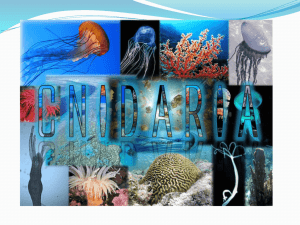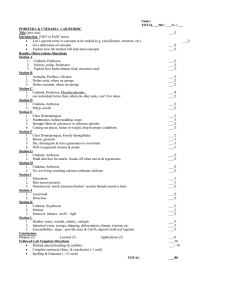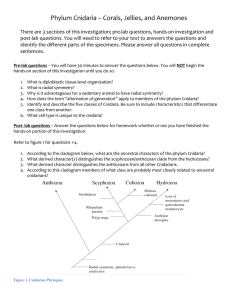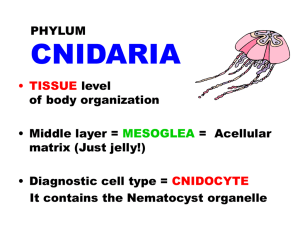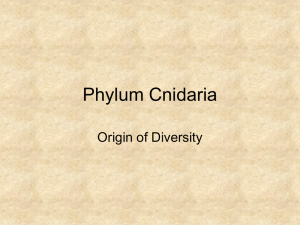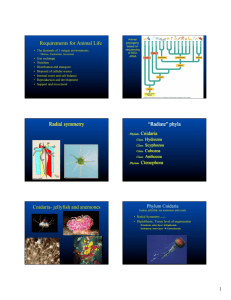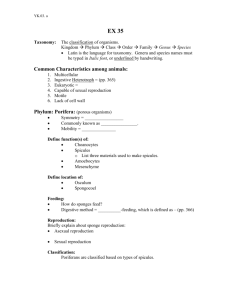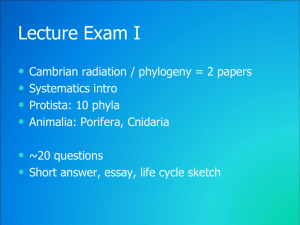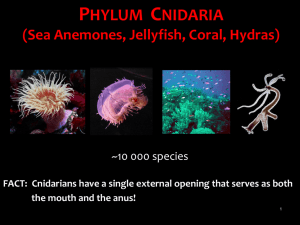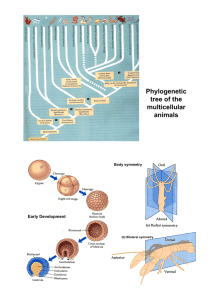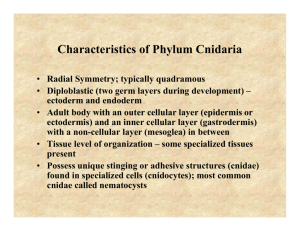Phylum Cnidaria – Cnidarians - Marine Benthic Fauna of Chilean
advertisement
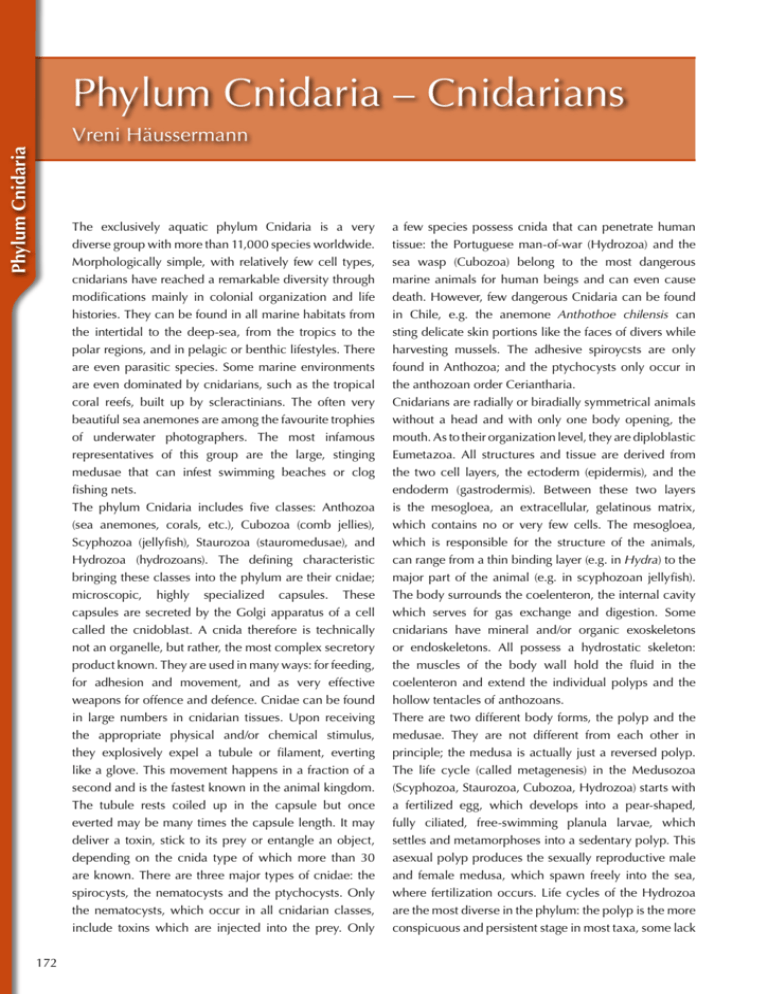
Phylum Cnidaria – Cnidarians Phylum Cnidaria Vreni Häussermann The exclusively aquatic phylum Cnidaria is a very diverse group with more than 11,000 species worldwide. Morphologically simple, with relatively few cell types, cnidarians have reached a remarkable diversity through modifications mainly in colonial organization and life histories. They can be found in all marine habitats from the intertidal to the deep-sea, from the tropics to the polar regions, and in pelagic or benthic lifestyles. There are even parasitic species. Some marine environments are even dominated by cnidarians, such as the tropical coral reefs, built up by scleractinians. The often very beautiful sea anemones are among the favourite trophies of underwater photographers. The most infamous representatives of this group are the large, stinging medusae that can infest swimming beaches or clog fishing nets. The phylum Cnidaria includes five classes: Anthozoa (sea anemones, corals, etc.), Cubozoa (comb jellies), Scyphozoa (jellyfish), Staurozoa (stauromedusae), and Hydrozoa (hydrozoans). The defining characteristic bringing these classes into the phylum are their cnidae; microscopic, highly specialized capsules. These capsules are secreted by the Golgi apparatus of a cell called the cnidoblast. A cnida therefore is technically not an organelle, but rather, the most complex secretory product known. They are used in many ways: for feeding, for adhesion and movement, and as very effective weapons for offence and defence. Cnidae can be found in large numbers in cnidarian tissues. Upon receiving the appropriate physical and/or chemical stimulus, they explosively expel a tubule or filament, everting like a glove. This movement happens in a fraction of a second and is the fastest known in the animal kingdom. The tubule rests coiled up in the capsule but once everted may be many times the capsule length. It may deliver a toxin, stick to its prey or entangle an object, depending on the cnida type of which more than 30 are known. There are three major types of cnidae: the spirocysts, the nematocysts and the ptychocysts. Only the nematocysts, which occur in all cnidarian classes, include toxins which are injected into the prey. Only 172 a few species possess cnida that can penetrate human tissue: the Portuguese man-of-war (Hydrozoa) and the sea wasp (Cubozoa) belong to the most dangerous marine animals for human beings and can even cause death. However, few dangerous Cnidaria can be found in Chile, e.g. the anemone Anthothoe chilensis can sting delicate skin portions like the faces of divers while harvesting mussels. The adhesive spiroycsts are only found in Anthozoa; and the ptychocysts only occur in the anthozoan order Ceriantharia. Cnidarians are radially or biradially symmetrical animals without a head and with only one body opening, the mouth. As to their organization level, they are diploblastic Eumetazoa. All structures and tissue are derived from the two cell layers, the ectoderm (epidermis), and the endoderm (gastrodermis). Between these two layers is the mesogloea, an extracellular, gelatinous matrix, which contains no or very few cells. The mesogloea, which is responsible for the structure of the animals, can range from a thin binding layer (e.g. in Hydra) to the major part of the animal (e.g. in scyphozoan jellyfish). The body surrounds the coelenteron, the internal cavity which serves for gas exchange and digestion. Some cnidarians have mineral and/or organic exoskeletons or endoskeletons. All possess a hydrostatic skeleton: the muscles of the body wall hold the fluid in the coelenteron and extend the individual polyps and the hollow tentacles of anthozoans. There are two different body forms, the polyp and the medusae. They are not different from each other in principle; the medusa is actually just a reversed polyp. The life cycle (called metagenesis) in the Medusozoa (Scyphozoa, Staurozoa, Cubozoa, Hydrozoa) starts with a fertilized egg, which develops into a pear-shaped, fully ciliated, free-swimming planula larvae, which settles and metamorphoses into a sedentary polyp. This asexual polyp produces the sexually reproductive male and female medusa, which spawn freely into the sea, where fertilization occurs. Life cycles of the Hydrozoa are the most diverse in the phylum: the polyp is the more conspicuous and persistent stage in most taxa, some lack the medusa phase, whereas others lack the polyp phase. The class Anthozoa does not possess a medusa stage; their gametes are produced in the polyp. Cnidaria are predominantly carnivorous, using their cnidae-loaded tentacles to capture prey. They are generally passive predators, feeding on what gets stuck to their tentacles. Some cnidarians can absorb dissolved organic matter directly from seawater. Some species, mainly in the class Anthozoa, host endodermal, unicellular algae in their tissue. Dinoflagellate symbionts, called zooxanthellae, are by far the most common algal symbionts, and especially important for the reefbuilding, zooxanthellate corals from tropical waters. Zooxanthellae can also be found in a few Chilean species (e.g. Bunodactis hermaphroditica, Anthopleura hermaphroditica). Green algal symbionts, called zoochlorellae, occur in both marine and freshwater cnidarians. The Scleractinia found in Chile belong to the azooxanthellate, cold-water corals that generally do not possess algal symbionts, but some species in the Chilean fiords live in close contact with endolithic algae, which could constitute a mutualistic partnership. Although cnidarians in the Chilean Fjord Region do not form the giant reefs known from tropical areas, they can locally be very abundant or dominating, and can form dense and extensive aggregations (sea anemones and gorgonians), banks (Scleractinia) and even little reef-like structures (stylasterid hydrozoans). Most spectacular are the discoveries of cold-water coral banks in the three northernmost fjords, formed by the scleractinian Desmophyllum dianthus, and hydrocoral reefs in the channels of the Central Patagonian Zone, formed by Errina antarctica. The taxon Cnidaria is thought to have one of the longest fossil histories of metazoan phyla with representatives in the Ediacaran fauna of the late Precambrian. Although skeleton-forming forms are represented best, even medusa and anemones have been found. The phylogenetic relationships of the Cnidaria have been debated strongly. However, scientists agree that Cnidaria is divided into reciprocally monophylectic two clades: Anthozoa and Medusozoa. The most widely accepted hypothesis is that anthozoans are the most basal group. The relationship between Cubozoa, Scyphozoa, Staurozoa and Hydrozoa are unclear; Hydrozoa is generally thought to be the most derived taxon. Relationships among anthozoans are also unclear. Bibliography Bridge, D., Cunningham, C.W., DeSalle, R. & Buss, L.W. (1995) Class-level relationships in the phylum Cnidaria: molecular and morphological evidence. Molecular Biology and Evolution, 12 (4): 679-689. Dunn, D.F. (1982) Cnidaria. In: Parker, S.P. (ed.) Synopsis and Classification of Living organisms. McGraw-Hill, New York, pp. 669-705. Fautin, G., D., Romano & L., S. (1997) Cnidaria. Sea anemones, corals, Bridge, D., Cunningham, C.W., Schierwater, B., Desalle, R. & Buss, L.W. jellyfish, sea pens, hydra. Version 24 April 1997. http://tolweb.org/ (1992) Class-Level Relationships in the Phylum Cnidaria: Evidence Cnidaria/2461/1997.04.24 http://tolweb.org/. In: The Tree of Life from mitochondrial genome structure. Proceedings of the National Academy of Sciences of the United States of America, 89 (18): 8750-8753. Web Project. Schuchert, P. (1993) Phylogenetic analysis of the Cnidaria. Zeitschrift für Zoologische Systematik und Evolutionsforschung, 31:161-173. 173
